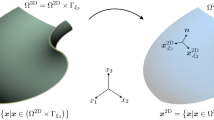Abstract
The present manuscript focuses on the algorithmic treatment of three-dimensional discontinuities within a purely displacement based finite element setting. In contrast to two-dimensional cracks, the local element based geometric representation of three-dimensional crack surfaces is non-unique and thus not straightforward. Accordingly, we compare different crack tracking strategies, one being algorithmically extremely efficient but yet somehow restrictive, the other one being more complex but rather general in nature. While the first method is able to represent entirely smooth discontinuity surfaces, the second approach introduces inter-element discontinuities in the overall crack surface representation. Both methods are compared systematically and additional comments about the algorithmic realization are provided. From the numerical results we conclude that neither of the two algorithms is able to solve all defined quality criteria satisfactorily, although both are mesh independent, computationally cheap and rather efficient. The ultimate solution might be an overall global crack surface representation that a priori circumvents a number of algorithmic deficiencies and at the same time provides a unique and smooth three-dimensional crack surface representation.
Similar content being viewed by others
References
Areias PMA and Belytschko T (2005). Analysis of three-dimensional crack initiation and propagation using the extended finite element method. Int J Numer Meth Eng 63(5): 760–788
Areias PMA and Belytschko T (2006). A comment on the article “A finite element method for the simulation of strong and weak discontinuities in solid mechanics” By A. Hansbo and P. Hansbo. [Comput. Methods Appl. Mech. Engrg. 193 (2004) 3523–3540]. Comput Methods Appl Mech Eng 195(9–12): 1275–1276
Dolbow J, Moës N and Belytschko T (2000). Discontinuous enrichment in finite elements with a partition of unity method. Finite Elem. Anal. Design 36(3–4): 235–260
Belytschko T, Moës M, Usui S and Parimi C (2001). Arbitrary discontinuities in finite elements. Int J Numer Meth Eng 50(4): 993–1013
Chaves EWV (2006) Tracking3D Crack Path. Proceeding of the International Conference on Mathematical and Statistical Modeling in Honor of Enrique Castillo ICMSM. Ciudad Real, Spain
Borst R (2003). Numerical aspects of cohesive-zone models. Eng Fract Mech 70(14): 1743–1757
Guitiérrez MA, Wells GN, Remmers JC, Askes H and Borst R (2004). Cohesive-zone models, higher-order continuum theories and reliability methods for computational failure analysis. Int J Numer Meth Eng 60(1): 289–315
Gasser TC and Holzapfel GA (2005). Modeling 3D crack propagation in unreinforced concrete using PUFEM. Comput Methods Appl Mech Eng 194(25–26): 2859–2896
Gasser TC and Holzapfel GA (2006). 3D Crack propagation in unreinforced concrete. A two-step algorithm for tracking 3D crack paths. Comput Methods Appl Mech Eng 195(37–40): 5198–5219
Moës N, Gravouil A and Belytschko T (2002). Non-planar 3D crack growth by the extended finite element and level sets - Part I: Mechanical model. Int J Numer Meth Eng 53(11): 2549–2568
Gravouil A, Moës N and Belytschko T (2002). Non-planar 3D crack growth by the extended finite element and level sets - Part II: Level set update. Int J Numer Meth Eng 53(11): 2569–2586
Hansbo A and Hansbo P (2004). A finite element method for the simulation of strong and weak discontinuities in solid mechanics. Comput Methods Appl Mech Eng 193(33–35): 3532–3540
Hansbo A, Hansbo P and Larson MG (2003). A finite element method on composite grids based on Nitsche’s method. ESAIM: Math Model Numer Anal 37(3): 495–514
Jäger P, Steinmann P, Kuhl E (2007) Modeling three-dimensional crack propagation. A comparison of crack path tracking strategies. (submitted for publication)
Jirasek M, Rolshoven S and Grassl P (2004). Size effects on fracture energy induced by non-locality. Int J Numer Anal Meth Geomech 28(7–8): 653–670
Mergheim J, Kuhl E and Steinmann P (2004). A hybrid discontinuous Galerkin/interface method for the computational modelling of failure. Commun Numer Meth Eng 20(7): 511–519
Mergheim J, Kuhl E and Steinmann P (2005). A finite element method for the computational modelling of cohesive cracks. Int J Numer Meth Eng 63(2): 276–289
Mergheim J and Steinmann P (2006). A geometrically non-linear FE approach for the simulation of strong and weak discontinuities. Comput Methods Appl Mech Eng 195(37–40): 5037–5052
Mergheim J, Kuhl E and Steinmann P (2007). Towards the algorithmic treatment of 3D strong discontinuities. Commun Numer Meth Eng 23(2): 97–108
Mergheim J (2006) Computational Modeling of Strong and Weak Discontinuities. PhD thesis, Lehrstuhl für Technische Mechanik, TU Kaiserslautern
Oliver J and Huespe AE (2002). On strategies for tracking strong discontinuities in computational failure mechanics. In: Mang, HA, Rammersdorfer, FG and Erberhardsteiner, J (eds) Proceedings of the Fifth World Congress on Computational Mechanics (WCCM V), pp. Austria, Vienna
Oliver J, Huespe AE, Samaniego E and Chavez EVW (2004). Continuum approach to the numerical simulation of material failure in concrete. Int J Numer Anal Meth Geomech 28(7–8): 609–632
Patzak B and Jirasek M (2003). Process zone resolution by extended finite elements. Eng Fract Mech 70(7–8): 957–977
Remmers JJC, Needleman A and Borst R (2003). A cohesive segments method for the simulation of crack growth. Comput Mech 31(1–2): 69–77
Sukumar N, Moës N, Moran B and Belytschko T (2006). Extended finite element method for three-dimensional crack modelling. Int J Numer Meth Eng 48(11): 1549–1570
Ventura G, Budyn E and Belytschko T (2003). Vector level sets for the description of propagating cracks in finite elements. Int J Numer Meth Eng 58(10): 1571–1592
Wells GN and Sluys LJ (2001). A new method for the modelling of cohesive cracks using finite elements. Int J Numer Meth Eng 50(12): 2667–2682
Wells GN, Sluys LJ and Borst R (2002). Simulating the propagation of displacement discontinuities in a regularized strain-softening medium. Int J Numer Meth Eng 53(5): 1235–1256
Author information
Authors and Affiliations
Corresponding author
Rights and permissions
About this article
Cite this article
Jäger, P., Steinmann, P. & Kuhl, E. On local tracking algorithms for the simulation of three-dimensional discontinuities. Comput Mech 42, 395–406 (2008). https://doi.org/10.1007/s00466-008-0249-3
Received:
Accepted:
Published:
Issue Date:
DOI: https://doi.org/10.1007/s00466-008-0249-3




